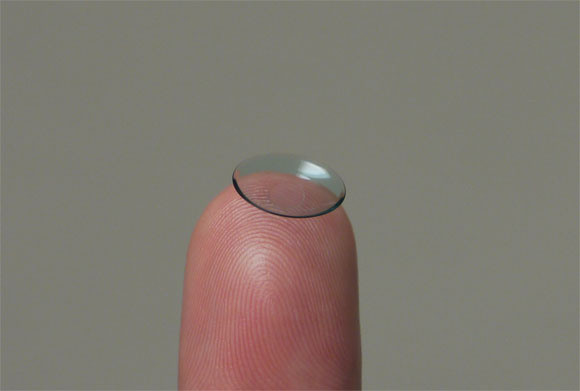
If you were asked to name a type of surgery to correct short-sightedness, most likely the first thing that would come to mind is laser eye surgery. While in recent years the precision levels and success rates of laser surgery have risen like never before, the idea of zapping your eye with a laser isn’t one that everyone is comfortable with. Recently, however, “orthokeratology”–a new form of vision correction which uses hard contact lenses to shape the cornea and requires no surgery whatsoever–is becoming increasingly popular.
Find out how our reporter Kuzo got on with a pair of the unique lenses after the break.
Left in overnight and removed upon waking, the lens’ shaping effects are said to allow the user to spend an entire day with perfect vision without the need for glasses or contact lenses. But how did our reporter fare?
- The science behind the lens
The special orthokeratology contact lens is designed in such a way so as to apply gentle pressure to the surface of the cornea, flattening it in a way that restores normal vision. Put simply, the contact lens corrects the way light is refracted when entering into the eyes. You simply pop them in before going to bed and then remove them the following morning.
Kuzo first started wearing this special type of contacts lens back in May 2011. He was so impressed with the results that he continues to use them even now. He reported that after using orthokeratology for just one night, both his eyes had been restored to 20/20 vision. Although Kuzo hasn’t had his sight tested recently, he claims that his vision is just as crisp as when he first started using the lenses two years ago. Whether it be lounging about in front of the TV, enjoying a movie or reading a book, he loves not having the restrictions that come with regular contact lenses or glasses. Dare we say that Kuzo often comments that his sight is a little too good?
- So what’s the best thing about orthokeratology?
Ultimately the biggest advantage has got to be that unlike normal contact lenses, your eyes don’t become dry, nor do they feel tired after hours of use. What’s more, as it’s not necessary to put anything in during waking hours, you’re eyes feel really healthy. Obviously in order to achieve this, wearing the contacts at night is a prerequisite, but as the wearing time coincides with your sleeping hours, most of the time you’re not even aware you’ve got them in.
- Are there any downsides we should be aware of?
Before heading to bed each night, it is necessary to insert the hard contact lenses into your eyes. At first, this might prove a bit fiddly and take some getting used to. There are also reports of your eyes feeling sore during the initial period of getting used to the lens. However, these are the same things reported by users who try hard contact lenses for the first time. The lenses used in orthokeratology are no different to normal hard contact lenses in terms of comfort, so once you pass this obstacle, it comes as almost second nature.
Another possible downside is that unlike laser surgery, the contact lenses need to be worn regularly to sustain effective results. For many, this means every night although it really does depend on how soft your cornea is and how long it takes for it to return back to its original state. Kuzo admits that after wearing the lenses for two whole years, even after missing a couple days of wear, there is little deterioration in his sight. However, in the early stages of use it is often required to put the lenses in every night so as to stabilize the shape of the cornea.
- What about the price?
In Japan, the lenses have only received official approval by the government in recent years so their uptake is still a little behind other countries. The optician that Kuzo visited charged 160,000 yen (about US$1,680) for both eyes but the price will of course vary from place to place. The price also seems to vary depending upon how much aftercare is included.
Most opticians in Japan providing orthokeratology also offer a free trial period which is ideal in finding out whether the product is right for you. For anyone curious about this type of non-invasive vision correction, the chances are that whether you’re residing in Japan or not, you’re local optician could well be offering a similar service. If you’re even the tiniest bit interested, why not go and check it out?
If you’ve tried, or are currently a user of, orthokeratological lenses and would like to share your views about it, we’d love to hear how they worked for you, so let us know in the comments section below.
http://www.youtube.com/watch?feature=player_embedded&v=m_akDyjSNuo
[ Read in Japanese ]
 Japanese bar hostess goes too far with the compliments, scares customer into going home
Japanese bar hostess goes too far with the compliments, scares customer into going home Very limited sale of glasses that can halt or reverse nearsightedness begin in Japan
Very limited sale of glasses that can halt or reverse nearsightedness begin in Japan Akiyuki Nosaka, celebrated author of Grave of the Fireflies, passes away
Akiyuki Nosaka, celebrated author of Grave of the Fireflies, passes away That time Seiji called JASRAC to ask why he didn’t get paid royalties for his song being on TV
That time Seiji called JASRAC to ask why he didn’t get paid royalties for his song being on TV Hayao Miyazaki says Happy New Year to Studio Ghibli fans with new art for Year of the Horse
Hayao Miyazaki says Happy New Year to Studio Ghibli fans with new art for Year of the Horse 7 great places to see Mt. Fuji from without having to climb it
7 great places to see Mt. Fuji from without having to climb it Draw like a Studio Ghibli anime artist with exclusive watercolour set approved by Hayao Miyazaki
Draw like a Studio Ghibli anime artist with exclusive watercolour set approved by Hayao Miyazaki We found possibly the quietest Japanese-style hotel in Tokyo’s bustling Shinjuku district
We found possibly the quietest Japanese-style hotel in Tokyo’s bustling Shinjuku district Nattoku! Factory offers free factory tours of a famous natto brand production process
Nattoku! Factory offers free factory tours of a famous natto brand production process A deep-fried sushi senbero awaits from Super Value【Japan’s Best Home Senbero】
A deep-fried sushi senbero awaits from Super Value【Japan’s Best Home Senbero】 We try all-you-can-eat raw eggs for 730 yen, turns out to be way better than it sounds
We try all-you-can-eat raw eggs for 730 yen, turns out to be way better than it sounds Usher good luck into your home this New Year with Totoro tenugui from Studio Ghibli
Usher good luck into your home this New Year with Totoro tenugui from Studio Ghibli Starbucks Japan ready to get Year of the Horse started with adorable drinkware and plushies【Pics】
Starbucks Japan ready to get Year of the Horse started with adorable drinkware and plushies【Pics】 Cyberpunk anime meets traditional culture in Ghost in the Shell gold leaf Japanese changing screens
Cyberpunk anime meets traditional culture in Ghost in the Shell gold leaf Japanese changing screens Hello Kitty Choco Egg figures are an adorable trip through three periods of Japanese pop culture【Pics】
Hello Kitty Choco Egg figures are an adorable trip through three periods of Japanese pop culture【Pics】 7-Eleven Japan’s ramen-cooking robot whipped us up a bowl of noodles【Taste test】
7-Eleven Japan’s ramen-cooking robot whipped us up a bowl of noodles【Taste test】 Japan’s otoshidama tradition of giving kids money at New Year’s gets a social welfare upgrade
Japan’s otoshidama tradition of giving kids money at New Year’s gets a social welfare upgrade Sumo Sanrio! Hello Kitty and pals team up with Japan Sumo Association for new merch【Pics】
Sumo Sanrio! Hello Kitty and pals team up with Japan Sumo Association for new merch【Pics】 More Than a Capsule Stay: Why Solo Travelers Choose “global cabin Yokohama Chinatown”
More Than a Capsule Stay: Why Solo Travelers Choose “global cabin Yokohama Chinatown” Japan’s oldest largetooth sawfish in captivity back on display in Mie Prefecture
Japan’s oldest largetooth sawfish in captivity back on display in Mie Prefecture 7-Eleven Japan starts new temporary luggage storage service in over 300 branches
7-Eleven Japan starts new temporary luggage storage service in over 300 branches Disillusionment at Tsukiji’s tourist-target prices led us to a great ramen restaurant in Tokyo
Disillusionment at Tsukiji’s tourist-target prices led us to a great ramen restaurant in Tokyo Starbucks teams up with 166-year-old Kyoto doll maker for Year of the Horse decorations【Photos】
Starbucks teams up with 166-year-old Kyoto doll maker for Year of the Horse decorations【Photos】 Tokyo considering law requiring more trash cans following litter increase in heavily touristed area
Tokyo considering law requiring more trash cans following litter increase in heavily touristed area Tokyo’s Tsukiji sushi neighborhood asks tour groups to stay away for the rest of the month
Tokyo’s Tsukiji sushi neighborhood asks tour groups to stay away for the rest of the month Tokyo event lets you travel back in time, for free, to celebrate 100 years since Showa era start
Tokyo event lets you travel back in time, for free, to celebrate 100 years since Showa era start Sanrio theme park in Japan announces plans to expand into a Sanrio resort
Sanrio theme park in Japan announces plans to expand into a Sanrio resort Japan may add Japanese language proficiency, lifestyle classes to permanent foreign resident requirements
Japan may add Japanese language proficiency, lifestyle classes to permanent foreign resident requirements Stamina-destroying “Paralysis Noodles” are Tokyo’s newest over-the-top ramen innovation
Stamina-destroying “Paralysis Noodles” are Tokyo’s newest over-the-top ramen innovation Survey asks foreign tourists what bothered them in Japan, more than half gave same answer
Survey asks foreign tourists what bothered them in Japan, more than half gave same answer Japan’s human washing machines will go on sale to general public, demos to be held in Tokyo
Japan’s human washing machines will go on sale to general public, demos to be held in Tokyo Japan’s deadliest food claims more victims, but why do people keep eating it for New Year’s?
Japan’s deadliest food claims more victims, but why do people keep eating it for New Year’s? We deeply regret going into this tunnel on our walk in the mountains of Japan
We deeply regret going into this tunnel on our walk in the mountains of Japan Studio Ghibli releases Kodama forest spirits from Princess Mononoke to light up your home
Studio Ghibli releases Kodama forest spirits from Princess Mononoke to light up your home Major Japanese hotel chain says reservations via overseas booking sites may not be valid
Major Japanese hotel chain says reservations via overseas booking sites may not be valid Put sesame oil in your coffee? Japanese maker says it’s the best way to start your day【Taste test】
Put sesame oil in your coffee? Japanese maker says it’s the best way to start your day【Taste test】 No more using real katana for tourism activities, Japan’s National Police Agency says
No more using real katana for tourism activities, Japan’s National Police Agency says Starbucks Japan reveals new sakura drinkware collection, inspired by evening cherry blossoms
Starbucks Japan reveals new sakura drinkware collection, inspired by evening cherry blossoms Updated cherry blossom forecast shows extra-long sakura season for Japan this year
Updated cherry blossom forecast shows extra-long sakura season for Japan this year
Leave a Reply